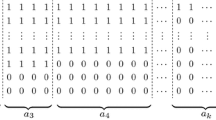Abstract
Let an [n, k, d] q code be a linear code of length n, dimension k, and with minimum Hamming distance d over GF(q). The ratio R = k/n is called the rate of a code. In this paper, [62, 53, 6]5, [62, 48, 8]5, [71, 56, 8]5, [124, 113, 6]5, [43, 36, 6]7, [33, 23, 7]7, and [27, 18, 7]7 high-rate codes and new codes with parameters [42, 14, 19]5, [42, 15, 18]5, [48, 13, 24]5, [52, 12, 28]5, [71, 15, 38]5, [71, 16, 36]5, [72, 12, 41]5, [78, 10, 50]5, [88, 11, 54]5, [88, 13, 51]5, [124, 14, 77]5, [32, 12, 15]7, [32, 10, 17]7, [36, 10, 20]7, and [48, 10, 29]7 are constructed. The codes with parameters [62, 53, 6]5 and [43, 36, 6]7 are optimal.
Similar content being viewed by others
References
MacWilliams, F.J. and Sloane, N.J.A., The Theory of Error-Correcting Codes, Amsterdam: North-Holland, 1977. Translated under the title Teoriya kodov, ispravlyayushchikh oshibki, Moscow: Svyaz’, 1979.
Daskalov, R.N. and Gulliver, T.A., Bounds on Minimum Distance for Linear Codes over G F(5), Appl. Algebra Engrg. Comm. Comput., 1999, vol. 9, no. 6, pp. 547–558.
Daskalov, R., Hristov, P., and Metodieva, E., New Minimum Distance Bounds for Linear Codes over GF(5), Discrete Math., 2004, vol. 275, no. 1–3, pp. 97–110.
Grassl, M. and White, G., New Good Linear Codes by Special Puncturings, in Proc. 2004 IEEE Int. Sympos. on Information Theory, Chicago, USA, 2004, p. 454.
Grassl, M. and White, G., New Codes from Chains of Quasi-cyclic Codes, in Proc. 2005 IEEE Int. Sympos. on Information Theory, Adelaide, Australia, 2005, pp. 2095–2099.
Maruta, T., Takenaka, M., Shinohara, M., and Shobara, Y., Constructing New Linear Codes from Pseudo-cyclic Codes, in Proc. 9th Int. Workshop on Algebraic and Combinatorial Coding Theory, Kranevo, Bulgaria, 2004, pp. 292–298.
Maruta, T., Shinohara, M., Yamane, F., Tsuji, K., Takanaka, E., Miki, H., and Fujiwara, R., New Linear Codes from Cyclic and Generalized Cyclic Codes by Puncturing, in Proc. 10th Int. Workshop on Algebraic and Combinatorial Coding Theory, Zvenigorod, Russia, 2006, pp. 194–197.
Maruta, T., Shinohara, M., and Takenaka, M., Constructing Linear Codes from Some Orbits of Projectivities, to appear in Discrete Math.
Braun, M., Kohnert, A., and Wassermann, A., Optimal Linear Codes from Matrix Groups, IEEE Trans. Inform. Theory, 2005, vol. 51, no. 12, pp. 4247–4251.
Daskalov, R.N. and Gulliver, T.A., Minimum Distance Bounds for Linear Codes over GF(7), J. Combin. Math. Combin. Comput., 2001, vol. 36, pp. 175–191.
Daskalov, R.N. and Gulliver, T.A., New Minimum Distance Bounds for Linear Codes over Small Fields, Probl. Peredachi Inf., 2001, vol. 37, no. 3, pp. 24–33 [Probl. Inf. Trans. (Engl. Transl.), 2001, vol. 37, no. 3, pp. 206–215].
Daskalov, R. and Hristov, P., New One-Generator Quasi-cyclic Codes over GF(7), Probl. Peredachi Inf., 2002, vol. 38, no. 1, pp. 59–63 [Probl. Inf. Trans. (Engl. Transl.), 2002, vol. 38, no. 1, pp. 50–54].
Rehfinger, T., Babu, N.S., and Zimmermann, K.-H., New Good Codes via CQuest—A System for the Silicon Search of Linear Codes, Algebraic Combinatorics and Applications, Betten, A., Kohnert, A., Laue, R., and Wassermann, A., Eds., Berlin: Springer, 2001, pp. 294–306.
Metodieva, E., Six New Linear Codes over GF(7), in Mathematics and Education in Mathematics, Sofia: BAN, 2004, pp. 158–161.
Brouwer, A.E., Linear Code Bounds [electronic table]. Available online at http://www.win.tue.nl/:_aeb/voorlincod.html.
Greenough, P.P. and Hill, R., Optimal Ternary Quasi-cyclic Codes, Des. Codes Cryptogr., 1992, vol. 2, no. 1, pp. 81–91.
Koshy, T., Polynomial Approach to Quasi-cyclic Codes, Bull. Calcutta Math. Soc., 1977, vol. 69, no. 2, pp. 51–59.
Séguin, G.E. and Drolet, G., The Theory of 1-Generator Quasi-cyclic Codes, Tech. Report of Royal Military College of Canada, Kingston, 1991.
Author information
Authors and Affiliations
Additional information
Original Russian Text © R. Daskalov, 2007, published in Problemy Peredachi Informatsii, 2007, Vol. 43, No. 2, pp. 65–73.
Supported in part by the Bulgarian Ministry of Education and Science under Contract in TU-Gabrovo.
Rights and permissions
About this article
Cite this article
Daskalov, R. Some high-rate linear codes over GF(5) and GF(7). Probl Inf Transm 43, 124–131 (2007). https://doi.org/10.1134/S0032946007020056
Received:
Issue Date:
DOI: https://doi.org/10.1134/S0032946007020056



